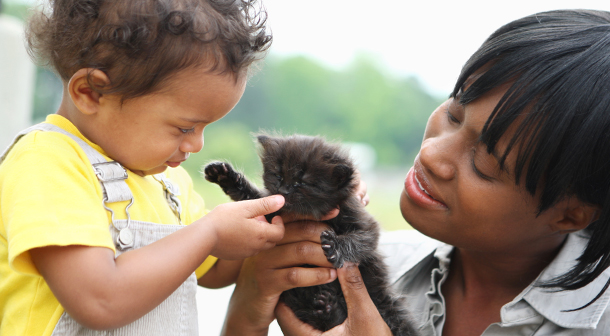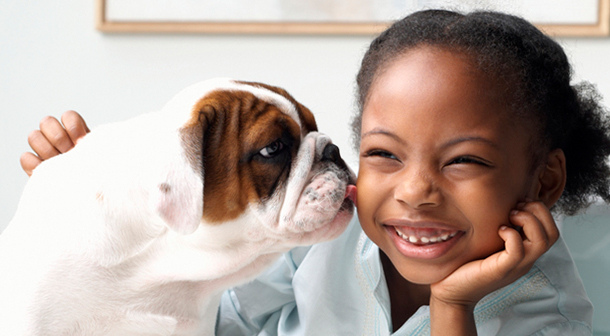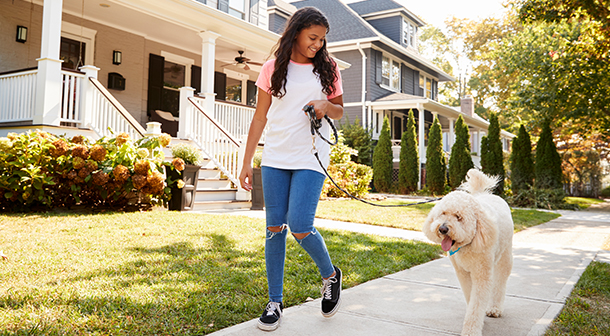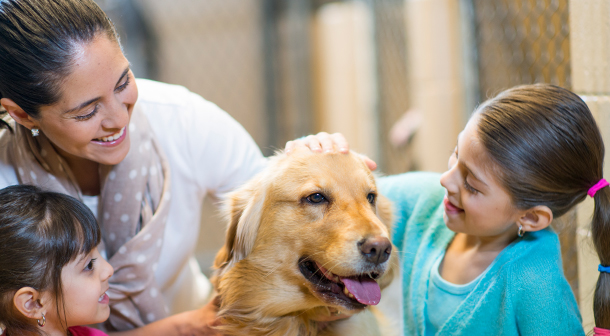Kid and Pets are Great Together
By GetParentingTips.com staff
Read Time: 10 Minutes
Family pets can be a source of comfort and fun for the whole family. They can be great playmates and snuggle buddies for kids. They can also teach children life lessons, responsibility, respect for living things, and make memories that will last a lifetime.
Having a family pet is a great opportunity to teach your children about caring for others. It's also a chance to give your kids responsibilities that can help them learn and develop.
Having a family pet helps kids develop:
- Confidence and self-esteem.
- Nonverbal communication skills.
- Trusting relationships.
- Compassion.
- Empathy.
- Respect.
- Patience.
Family pet care can be a great experience for kids and pets. But it's important not to give children more responsibility than they can safely handle. Make sure you have realistic expectations about how much of the pet care your child can manage. Ultimately, it's your job as the adult to ensure that your pet is being properly cared for.

Safe ways for kids of every age to help with family pet care
Age 3 and Under
Kids this age can:
- Learn how to be kind and gentle to pets.
- Understand the rules of family pet care to keep pets and kids safe: No pulling tails, no picking up pets without a grownup, don't bother a pet that is eating, don't tap on fish tanks, and don't tease a pet.
- Help with family pet care. Children this age should not be responsible for taking care of a family pet, but they can learn where the food is kept and assist a grownup or older sibling with feeding the pet.
Safety first!
Never leave a cage, tank, or litter box within reach of a young child. Small children can upset cages or tanks, harming the pet or exposing themselves to germs that can make them sick.
Age 4-5
Kids this age can:
- Learn the proper ways to pet an animal.
- Give a treat, with permission from a grownup.
- Assist with feeding and walks.
Age 6-8
Kids this age can:
- Teach a pet simple tricks.
- Brush a pet's hair. Make sure it's from head to tail, always in the direction the coat is growing.
- Walk a small dog in an enclosed yard with adult supervision.
- Help walk a larger dog.
- Clean a cage, tank, or terrarium with help from an adult. It's important to teach good hand-washing skills. Cages can carry harmful germs and bacteria.
Ages 9-11
Kids this age can:
- Be taught to walk a dog and take the dog on short walks with an adult close by to help. The age at which it's appropriate for a child to walk a dog by himself (or herself) depends on the dog's ability to walk on a leash, the size of the dog, and how the dog reacts to other animals. For example, does the dog try to chase squirrels, or bark and pull when she sees another dog? If so, you may not want your child to walk this dog by himself.
- Feed an animal on schedule. See the tip below for more information about feeding animals.
- Clean up after a dog or clean a bird cage or litter box. Be sure to teach your child how to do this in a sanitary way and model proper hand-washing afterwards.
- Give a pet a bath.
Age 12 and up
- If properly taught, kids this age can handle pretty much any family pet care task or responsibility.
Feeding your pet.
Ask your veterinarian how much food your pet should be eating each day and how often it should be fed. Dogs and cats may need to be fed twice a day, while a bird may need pellets one day and fresh fruit and vegetables the next day. Lizards may eat insects, meat, plants, or a combination. Pet fish need to be fed once or twice a day.

Tips for keeping kids and pets safe
Never leave a very young child alone with a family pet.
Fish tanks can tip over. Birds can bite. Children age 5 and younger may see the pet as more of a toy than a living creature and may unintentionally provoke the animal to bite. Very young children should always be monitored when they are with family pets.
Follow the Golden Rule.
Make sure your child knows to treat animals the way he would want to be treated. That means no teasing, bullying, or abusive behavior. If a child can't follow these rules, it's better to find the pet another home.
Teach your child how to properly greet a dog or cat.
Always get the owner's permission. It's best not to make eye contact with a new dog or cat. Before greeting the animal, stand still while she sniffs you, then calmly extend your hand to pet it on the shoulder or back, not the head or tail. Look for signs that an animal does not want to be petted. For a dog, that could be a stiff body and tail, barking, and crouched position. For a cat, a low or puffed-out tail, an arched back, and hissing are all signs that the cat is not happy or feels threatened.
Children need to be old enough to walk a dog.
The appropriate age for children to walk a dog by themselves depends on the dog's ability to walk on a leash, the size of the dog, and how the dog reacts to other animals. If a larger dog pulls on a leash to chase a squirrel or to meet another dog, this could easily knock a child down, causing him to potentially lose control of the dog, become injured, or both. Children can practice and learn how to walk their dog in a fenced-in yard or other outdoor enclosed area, such as a dog park, under the supervision of an adult.
Need parenting help now?
The Texas Parent Helpline is available 24/7.
- Call 833-680-0611
- Chat with us
- Text 833-680-0611

Best pets for kids
Whether this is your family's first pet or you're thinking of adding another animal to the mix, there's a lot to think about when getting a new pet. For the best experience with having a family pet, it's important to think through the specific needs of the kinds of pet you are considering. Dogs and cats need room to exercise, play, eat, and sleep. Any animal in a cage will need regular cleaning, care, and monitoring to stay healthy and happy.
In addition to thinking about the daily tasks of pet care, consider how long you might have a particular family pet. Animals have a broad range of life spans, so make sure you consider that when picking a pet. Also think about the age of your children. For example, you may ask what's the best pet for toddlers versus a school-age child.
- Dogs live 8–13+ years. They require lots of care and attention, and they must be let out or walked to relieve themselves.
- Cats live 15–20 years. They use a litter box that needs daily cleaning, and they require daily care and attention.
- Fish live up to 3 years. Betta fish, for example, can make a good pet for any age.
- Guinea pigs weigh up to 3 pounds and live 5–10 years. They need a large cage and do not like to live alone.
- Hamsters are nocturnal and easy to care for. They live 2–3 years and need a cage.
- Gerbils live 2–3 years and are easy to care for. They are social animals that do not do well living alone. Gerbils need a cage that's large enough for them to explore.
- Parrots live up to 80 years! They need a large cage.
- Corn snakes live 5–10 years and can grow up to 5 feet. They need a terrarium and fresh rodents for food.
- Turtles live up to 40 years and need a terrarium with shallow water, a large rock to perch on, and a dry area to burrow in.
- Hermit crabs live up to 30 years and live in terrariums with sand to dig and rocks to climb.
- Ferrets live 5–8 years. They are temperamental and may nip. Ferrets like to roam the house, but also need a cage.
- Rabbits live 5–10 years. They use a litter box and some can be trained to walk on a leash. Rabbits need an enclosure and lots of exercise.

Thinking of adding a dog or cat to your family? Here are some important factors to consider.
Do some research on which breeds of dogs are best for kids.
The American Kennel Club has some great resources about the personalities and needs of different breeds and which ones make good family dogs.
Ask about allergies.
If anyone in your family has asthma or allergies to pet dander, check with your pediatrician or a veterinarian about which animals to avoid as pets.

Take into consideration the needs of your current pet(s).
Do you have a cat that is nervous around dogs? An older dog who is very territorial? It may be difficult for some animals to adjust to a new pet. If possible, introduce your current pet to a potential new pet and let them spend some time together to see if they have good chemistry.
Think about what kind of family pet is best for your family's schedule and lifestyle.
Do you travel frequently? Do kids' activities keep you away from home a lot? If so, a dog or cat may not be the best fit for your family. If you have a pet that needs care during the day such as a younger dog or a dog or cat with medical needs, will someone be able to come home during the day? Or can you afford to hire someone to do this? If it's an issue, consider getting an older dog (2-3+ years old) that is already house trained and can wait a little longer to go to the bathroom.
Plan for pet expenses.
Do the math on food, shelter, cleaning, and visits to the vet before you bring a pet home. Depending on the age and type of dog or cat, your pet may need:
- Annual checkups.
- Preventative medication.
- Shots.
- Grooming.
- Treatment for unforeseen injuries and illnesses.
- Training and enrichment. A little training will increase your bond and make situations safer and more pleasant for everyone.
Babies and Pets
Are you bringing a baby home to a house with one or more pets? A hamster or a fish won't likely notice the newest addition, but dogs and cats will. Combining dogs and cats with newborns requires a little extra planning. Here are some tips for introducing your dog or cat to your baby.
In the weeks before your baby is born:
- Make any necessary changes to your dog's routine, like where she sleeps and when she goes for walks, so that she doesn't associate big changes with the baby.
- Introduce the dog to the smell of the baby's lotions and creams.
- Play recorded baby sounds at home.
When you bring your baby home from the hospital:
- Greet your dog alone, so that she doesn't jump on the baby.
- Let your dog get used to the smell and sight of the baby before letting her get too close.
Bringing home baby.
To help make it easier when dealing with dogs with newborns, introduce the baby's scent to your dog before bringing the baby home. Put a blanket or piece of clothing the baby has worn near an area where the dog normally lays. This will help the dog become familiar with the new smell of the baby.
After a few days:
- Allow the dog, while on a leash, to smell the baby.
- Give praise and pet her as she sniffs.
- Allow a dog or cat to choose when she interacts with the baby. Always supervise.
- Let your cat meet the baby in a quiet room. Let her sniff the baby, and reward her calm behavior with a treat.
Ongoing:
- Give your family pets plenty of attention.
- Don't scold the dog for taking the baby's toys. It's natural behavior, and you don't want her to have any negative association with the baby.
- Don't let the baby pull on your dog or cat's tail or ears.
- Never leave the baby alone with a family pet.
- Have a safe place for your pet to retreat when she needs time away from the baby.
- Consider keeping pets away from the baby's room with a gate.
Pet Adoption and Fostering
Giving a home to an animal in need is a great way to introduce a family pet. Working with a rescue group to foster animals is a wonderful service you and your family might want to consider. Fostering allows you to enjoy caring for an animal and to see if you're ready for a family pet.
If you want to adopt a pet, take your time and make a choice that's right for your family. It's good to do research before you commit to bringing a pet home. If the animal you are considering adopting is being fostered, talk to the person fostering the animal to get a sense of the animal's personality and whether she would make a good family dog. For example, does the dog already have experience being around children, or would the dog do better in an adults-only home? The American Kennel Club has a helpful list of questions to ask before you get a dog from a shelter. They can help you understand the best dogs for kids.
Can't have a pet of your own?
You can still raise an animal lover by:
- Visiting farms and petting zoos.
- Volunteering at animal shelters.
- Fostering animals.
- Taking a turn caring for the class pet.
- Bird watching.
- Observing animals like frogs and lizards in their natural habitats.
- Visiting friends with animals.
Animals and kids can be a great combination! Whether you are considering adding a family pet or finding ways for your child to help more with pet care, consider the animal's needs, take safety precautions, and think through your child's ability to give the animal the love and care it deserves. Taking these steps will ensure your child and your pet have the best possible experience.




